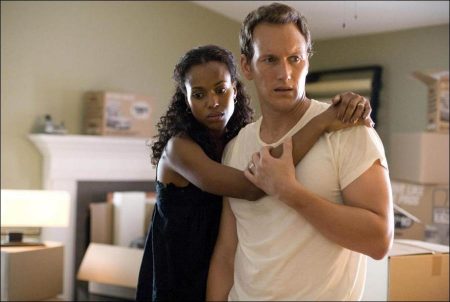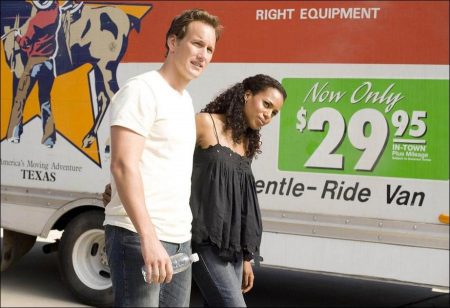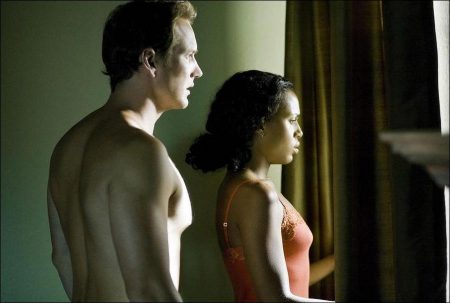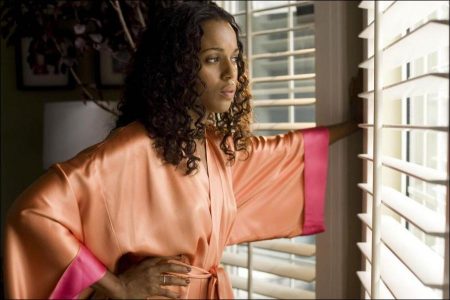Tagline: What could be safer than living next to a cop?
Lakeview Terrace movie storyline. Chris (Patrick Wilson) and Lisa Mattson (Kerry Washington), a progressive and upwardly mobile couple, move in next door to Turner, who disapproves of their interracial marriage. Hoping to rid the neighborhood of anything or anyone he deems “undesirable,” Turner launches an escalating series of pranks and insults against the Mattsons. From ignoring their request to focus his high-voltage safety lights away from their bedroom to disrupting a housewarming party, Abel takes full advantage of his police connections to antagonize his new neighbors with impunity, hoping to get them to pick up and move out.
When their air conditioning unit is sabotaged in the middle of a heat wave and their car tires are mysteriously slashed, the Mattsons begin to suspect Abel is behind their troubles. But without proof, they can only try to negotiate a truce-an offer Abel does not accept. Abel’s anger flares when his use of inappropriate force on the job lands him on extended leave and he discovers his daughter has been spending time with Lisa. Devoting himself fulltime to harassing his young neighbors, he raises the stakes by hosting a raucous bachelor party at his house that goes on into the wee hours.
With music still blasting at 3:00 am, Chris attempts to reason with Turner in an attempt to get some quiet. But Abel turns the tables on Chris, forcing him into a compromising position with the party strippers that is taped and presented to Lisa. As Abel crosses the line from annoying neighbor to dangerous adversary, the couple tries to fight back, which only feeds Turner’s fury. With the resentment between the neighbors building daily, it’s only a matter of time before the situation escalates into a potentially deadly stand off.
About the Production
“Not everybody here is someone you’d choose to live next to.” – Abel Turner
“A lot of people have asked me what the whitest white guy in America is doing writing a movie that deals with interracial issues,” says Lakeview Terrace screenwriter David Loughery. “I wanted to challenge myself and kind of get outside my comfort zone, so I wrote a thriller that dealt with issues we don’t usually see in that context.”
Loughery thinks many people will see themselves in the characters he has created. “I think people will identify with the situation. Whatever feelings they have about race and color and relationships, they’ll bring to the theater and they will compare it to the action we’re seeing on screen.”
Director Neil LaBute exploded onto the movie scene with his 1997 feature film debut, In the Company of Men, a razor sharp exploration of sexual politics. In the succeeding years, LaBute has built a reputation as a controversial filmmaker and playwright who is unafraid to pull back the mantle of civility covering the ugliest side of human nature.
For Loughery, La Bute’s unique sensibilities made him the perfect director for Lakeview Terrace. “This is a guy who really knows how to push an audience’s buttons,” he points out. “The films he makes and the plays he writes are-in a good way-excruciating to sit through, because the situations he creates are so incredibly uncomfortable. I knew that Neil would bring something to this movie that another director couldn’t. He brought a real tension to it, so the behavior between these characters feels very, very real.”
When the script for Lakeview Terrace came his way, LaBute saw an an opportunity to create a complex story, set in Los Angeles, that could be interpreted on many different levels. “I’d been living in Los Angeles long enough to be aware of the idea of fires encroaching on homes and racial tension and that kind of road rage thing,” says LaBute. Although the clash of opposites in the movie is racially charged, LaBute and Loughery are in agreement that the issue of race is just one facet of the escalating battle between neighbors in the story.
“Lakeview Terrace isn’t so much about race as it is about personal space, boundaries, turf and the lengths people will go to protect their property,” says the writer. “I think everybody has had a situation here they’ve just moved in next to somebody who is ruining the quality of your life. It may be a barking dog or a kid with a garage band or something else, but we all know how little things between neighbors can escalate into gigantic feuds. This is the ultimate version of that story.”
“The conflict is about someone who has grown up with a certain set of values and doesn’t believe in the kind of arrangement he sees across the fence,” says the director. Everyone has lived next door or under or over another person, and felt `Oh my God, what are they doing in there? Why are they making that noise at this time?’ When one of those neighbors is a policeman, it removes that first line of defense and makes for a very suspenseful sense of, `What do I do now?’
“That element is certainly not a racial element,” LaBute continues. “You could pick a good actor of any ethnicity for the part of Abel Turner. Tommy Lee Jones, Edward James Olmos, they could play the part of this man who is someone who will not give in to his neighbors.”
In the end, says Loughery, he wants the audience to be uncomfortable watching Lakeview Terrace. “I want them to kind of twitch in their seats, but at the same time I want to make sure that they’re entertained and have a great time.”
Jackson knew LaBute’s background as a playwright would be instrumental in developing the script and the characters. “Neil had a very interesting take,” says Jackson. “He also allowed us to come up with things that worked and fit into the story. He let us do the things we needed to do to bring a sense of reality and honesty.”
Actress Kerry Washington, who plays Lisa, says the strength of the script’s characters and story are the key to its dramatic success. “The film is really well written,” says the actress, probably best known for her portrayal of Ray Charles’ wife Della Bea Robinson in Ray. “For me, the best films are about ordinary people in extraordinary circumstances and this film is mostly about three ordinary people who just find themselves in the wrong place at the wrong time. Abel, Chris and Lisa are all pretty normal people who have pressures of the world thrown on them, from pregnancy to death. Life seems impossible to navigate. We find these people at their breaking points.”
Patrick Wilson, who plays Lisa’s husband Chris, praises LaBute’s ability and willingness to explore the complexities of the interactions between the story’s three principals. “He knows how to capture flawed relationships and take you where these characters are going,” says the actor. “He keeps driving the characters forward. He always knows what they want. That comes from being such a great playwright. There’s also a real directness and rawness in his writing that I love. He gives men especially really rich characters.”
“Neil is amazing,” concurs Washington. “He’s one of these people who always has a sense of humor. Whether it’s 7 a.m. or midnight, he’s there in good spirits. And he’s a real team player. He respects everybody in their various positions and he wants everybody to do their best job. To me, that’s the most important thing about a director, being able to hire the best people possible and then let them work their magic and you see him do that with every department. He really allows everybody to be a part of the process-that’s what I love about filmmaking-it is really a collaborative effort.”
Hot Hot Hot
Wanna call the cops? I’ll tell you who’s on duty. – Abel
Walnut, California, where Lakeview Terrace was primarily filmed, is located about 25 miles east of Los Angeles. The cul-de-sac on which Turner and the Mattsons live is set against the magnificent hill and canyon terrain of the area.
“One of the things I wanted to do in this script was set the story against a backdrop of the way we live here in Southern California,”says Loughery. “We think we’re safe and secure, but nature has its own ideas.
“The community where Abel, Chris and Lisa live is built right into the side of these hills and it’s constantly being threatened by mudslides, earthquakes and fires,” he explains. “In this story, almost from the day they move into this house, there’s this sense of this fire that’s out of control and slowly approaching. As the drama heats up between these characters, there’s this real kind of apocalypse just over the other side of the hill.” The specificity of the location required finding homeowners willing to give up their houses for five weeks and a community that would accept a film company on their street for the 25-day shoot.
The filmmakers took advantage of an unusual tool in the first stages of their search-Google Earth, an online service that provides users with an aerial view of entire neighborhoods. “We looked at a lot of houses,” says production designer Bruton Jones. “We explored different neighborhoods and then just went up to people’s doors and knocked. I have to say, our society can be very trusting. Because, here we were, strangers, standing there saying, `Hi, we know you have a pool in the back of your house. Can we look at it?’”
“We ended up in Walnut, which is a traditional, planned community,” says Jones. “It ultimately met a lot more of our requirements than the alternatives. It had many of the visual references in the script, particularly the way you can see from one neighbor’s yard into the other and from one window to the other.”
“Although we were in a suburban neighborhood, we didn’t want the houses to be cookie cutter kind of houses where each one is exactly the same,” says LaBute. “We wanted the contrast between our two main houses to be strong. Even though the cul-de-sac had mostly Spanish style homes, including Abel’s home, we were lucky to find one for Chris and Lisa that is kind of a faux Cape Cod home.”
Lakeview Terrace was the production designer’s first experience working with LaBute. “What a director brings to a script automatically sets the tone of the shoot,” says Jones. “And with Neil, he brings a lot to the table. He’s a bit controversial and very cerebral. There’s often a subtle subtext going on underneath, which allowed me to explore things a little bit more than usual.”
LaBute and Jones decided to create interiors that reflected the lifestyles and values of the two families to provide a visual illustration of their differences. “We talked about color and about the furnishings,” he says. “Abel’s home is more of a warm, nurturing environment that centers around kids, as opposed to the Mattson’s more hip, cool environment.”
The filmmakers were also trying to create a visual reflection of the climbing temperatures, blazing fires and flaring tempers. To create a cohesive look, the filmmakers and department heads tried to put together the sets, lighting and costumes that would reflect the film’s fiery themes.
Jones continues, “For the Turner house, we added little red elements. We wanted to show that Abel was the impetus of the dynamic relationship with his neighbors. To the red, we added oranges and yellows throughout the house-subtly-so that you could just see it in the background.
“The color palette of Chris and Lisa’s’ surroundings is a reflection of who they are both internally and externally,” says the designer. “Chris and Lisa’s world is more graphic and culturally diverse on the surface. Sophisticated colors and graphic patterned fabrics surround their world. Their use of common icons of culture is an attempt to validate their superficial embrace of their diversity.”
Along with Jones and LaBute, director of photography Rogier Stoffers and costume designer Lynette Meyer helped give Lakeview Terrace its unified look. Meyer, who has worked with LaBute on many of his previous films, understood the importance of the smallest details, like the red accents in Celia Turner’s clothing and Lisa Mattson’s graphic and hip, Northern California style.
“We wanted the characters to look comfortable and real,” says Meyer. “The color palette we used was very warm, which communicates heat both physically and subconsciously.
“The Lisa Mattson character,” Meyer continues, “definitely needed to be `organic’ and natural. I used a lot of `eco-friendly’ designers and fabrics to convey that feeling in order to be very different from the Abel Turner character and his world. Also, Kerry Washington is very interested in the `conscientious clothing movement’ and she was very involved in her look for the film. And finally, I wanted to create a character who was fashionable, earthy, yet sexy and not a cliché.”
Another key player in creating the unique look and feel of the film was Ben Bray, the renowned stunt coordinator, who has worked on films as diverse as No Country for Old Men, The Chronicles of Narnia and I Heart Huckabees.
Kerry Washington loved the challenge of performing her own stunts and was wowed by Bray’s expertise. “He’s fantastic,” she says of the veteran performer. “The first time Sam and Patrick and I saw the final sequence, it was like we were three kids watching the “Nutcracker” ballet for the first time.
“It was so exciting to see them do these movements so expertly and I hope we came close to what they did,” says the actress. “A lot of times when stunt coordinators choreograph things, they’re not necessarily choreographing for the actors. They’re choreographing for their stunt guys or things that they do well or want to do themselves. You always want to pay attention and let people know that you know what you’re doing and you understand what their job is.”
Jackson echoes that thought when he says, “It’s surprising to them sometimes to know that you can actually do it and do it in a specific way that makes it look as good as what they thought it was going to look like. So, it’s kind of fun to do.”
But he also says, “I did as much as I could. But I let the stunt guy do some too. You know, stunt guys like to get knocked down. So, if we hire them, we might as well let them get knocked down.”
Bray says he had an ideal experience on this film. “It’s more of a challenge when you have to keep it realistic, but from our first initial meeting, what I tried to push was that the stunts should not look like stunts,” he says. “Everything needed to be real and gritty and not look like it’s choreographed at all. Luckily, Neil and I were on the same page when it came to that. His notes were that we should just make it look as realistic as possible. And that’s what we’ve done.
“He knows exactly what he wants and that’s the easiest to way work,” says Bray. “I wish all directors were like him.”
Lakeview Terrace (2008)
Directed by: Neil LaBute
Starring: Samuel L. Jackson, Patrick Wilson, Kerry Washington, Eva La Rue, Bitsie Tulloch, Jay Hernandez, Justin Chambers, Jaishon Fisher, Regine Nehy, Keith Loneker, Michael Sean Tighe
Screenplay by: David Loughery
Production Design by: Bruton Jones
Cinematography by: Rogier Stoffers
Film Editing by: Joel Plotch
Costume Design by: Lynette Meyer
Set Decoration by: Don Diers
Art Direction by: Paul Sonski, Thomas T. Taylor
Music by: Jeff Danna, Mychael Danna
Music by: Jeff Danna, Mychael Danna
MPAA Rating: PG-13 for for intense thematic material, violence, sexuality, language and some drug references.
Oizüdisuüeo sl: Sony ScreenGems
Release Date: September 19, 2008
Views: 71








